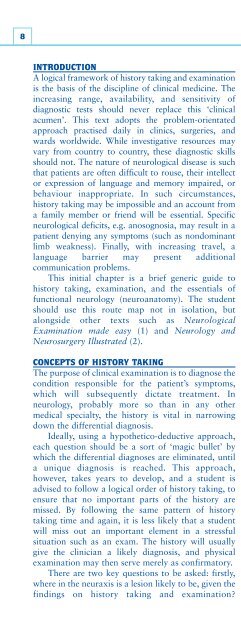You also want an ePaper? Increase the reach of your titles
YUMPU automatically turns print PDFs into web optimized ePapers that Google loves.
8INTRODUCTIONA logical framework of history taking and examinationis the basis of the discipline of clinical medicine. Theincreasing range, availability, and sensitivity ofdiagnostic tests should never replace this ‘clinicalacumen’. This text adopts the problem-orientatedapproach practised daily in clinics, surgeries, andwards worldwide. While investigative resources mayvary from country to country, these diagnostic skillsshould not. The nature of neurological disease is suchthat patients are often difficult to rouse, their intellector expression of language and memory impaired, orbehaviour inappropriate. In such circumstances,history taking may be impossible and an account froma family member or friend will be essential. Specificneurological deficits, e.g. anosognosia, may result in apatient denying any symptoms (such as nondominantlimb weakness). Finally, with increasing travel, alanguage barrier may present additionalcommunication problems.This initial chapter is a brief generic guide tohistory taking, examination, and the essentials offunctional neurology (neuroanatomy). The studentshould use this route map not in isolation, butalongside other texts such as NeurologicalExamination made easy (1) and <strong>Neurology</strong> andNeurosurgery Illustrated (2).CONCEPTS OF HISTORY TAKINGThe purpose of clinical examination is to diagnose thecondition responsible for the patient’s symptoms,which will subsequently dictate treatment. Inneurology, probably more so than in any othermedical specialty, the history is vital in narrowingdown the differential diagnosis.Ideally, using a hypothetico-deductive approach,each question should be a sort of ‘magic bullet’ bywhich the differential diagnoses are eliminated, untila unique diagnosis is reached. This approach,however, takes years to develop, and a student isadvised to follow a logical order of history taking, toensure that no important parts of the history aremissed. By following the same pattern of historytaking time and again, it is less likely that a studentwill miss out an important element in a stressfulsituation such as an exam. The history will usuallygive the clinician a likely diagnosis, and physicalexamination may then serve merely as confirmatory.There are two key questions to be asked: firstly,where in the neuraxis is a lesion likely to be, given thefindings on history taking and examination?Secondly, what is the nature of the causal lesioninferred by the tempo of illness presentation?Insidious and progressive symptoms may becompatible with tumour or degenerative illness. Asudden onset and improving symptoms could be dueto vascular disease. A subacute onset of symptomslasting a few weeks before resolving may be due todemyelinating disease such as multiple sclerosis.In order to answer these questions, it is importantto have a good understanding of the anatomy andphysiology of the nervous system. Once understood,neurology loses its mystery and is arguably the mostlogical of all the medical subspecialties in terms ofutilizing information available from clinicalexamination to localize the site and nature ofpathology.TAKING THE HISTORYTHE PRESENTING COMPLAINTEnquiry must be focused; a complaint of headacheshould not be met with an endless list of apparentlyunconnected questions about all other possiblesymptoms. This will tire both the patient and doctor.However, anticipating and enquiring into allpotentially relevant symptoms form a vital part ofhistory taking. For instance, memory loss,personality change, hearing loss, and double visionmay accompany headache (to name but a fewpossibilities). Each of these additional complaintscontributes importantly to defining a pathologicalprocess, anatomical localization, and targetedexamination.The pathological processes that affect the centraland peripheral nervous systems are relatively few.Pathological processesConditions can be inherited, developmental, oracquired:Infection (e.g. meningitis)Inflammation (e.g. multiple sclerosis)Ischaemic (trauma and stroke)Neoplastic (primary and secondary tumours)Degenerative (e.g. Parkinson’s disease)Toxic/metabolicKnowledge of these pathological possibilitiesleads to the first set of key questions.
















